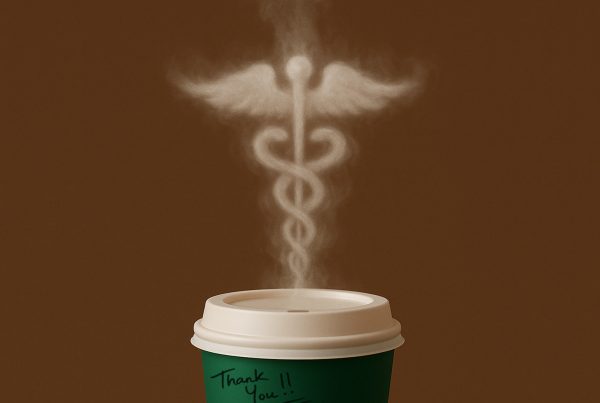The Big Story: How one health system rewrote a menu and big cliché
“A critical turning point for Northwell occurred when its leaders realized how much food — treated as a bare necessity — colors people’s perceptions of quality care. In surveys, focus groups and listening sessions, patients told Northwell leaders the food was so poor “it basically diminished all the great work that we’ve been doing in clinical care.”
Both/And
By David Shifrin
3-minute read
Like that Jell-O salad your aunt brings to Thanksgiving dinner every year – the one no one likes but eats anyway to avoid hurt feelings – hospital food has long been a joke.
Northwell Health, for one, has decided to put its track record as one of the country’s most innovative (and inclusive and good-to-work-for) companies, to work by ending the running gag. With “a waitlist of chefs who want to work at Northwell,” the system’s food – all 10 million meals served annually – looks and tastes less like a toddler’s plastic kitchen set and far more like the first-rate Thanksgiving many of us are still waking up from.
And if cheeseburgers are more your thing, Women’s Hospital in Baton Rouge has you covered with a post-partum burger that is getting fans outside the maternity ward.
Elisabeth Rosenthal, former ED physician and vocal industry observer, expressed a more skeptical view of gourmet menus and high-end amenities in healthcare. In a recent article for The Atlantic titled Hospitals Have Gotten Too Nice, she suggests high-end food may be a marketing spin to gin up demand and not necessarily an important part of a holistic care experience.
“We’re suckers for this type of thing, and the industry knows that even small comforts can make us feel better, regardless of whether we’re actually getting better,” she wrote.
Rosenthal cited a 2008 report by the National Bureau of Economic Research that said while investing in clinical quality would result in a 13 percent increase in demand, investing in amenities would boost it by a whopping 38 percent.
“More recently, hospital executives told The Boston Globe that the main reason hospitals have moved in this direction is that ‘people’s expectations have changed,’ and it creates a ‘competitive advantage’ that can be marketed to potential customers,” she plated.
Wait. What’s wrong with having a competitive advantage? And isn’t good food good medicine, too?
What’s the balance between creating a comfortable environment, trying to take the edge off high-stakes events that are usually among the most difficult people will ever experience and going overboard with high-end amenities…or even “small comforts”?
While we can’t speak to your financials or advise you on how to allocate resources, here are a few reasons why better food is a good example of a healthy campaign.
It’s a false choice. One criticism of Rosenthal’s stance is that she sets up an either-or situation. Rather than building marble lobbies with pianos and going overboard on food, why not invest in making appointment scheduling easier, she asks. Or in adding staff to cut wait times?
True, not every “improvement” is necessary for improving the patient experience or the best use of limited resources. Tough choices must be made. But a choice to serve better coffee doesn’t necessarily have to come at the expense of improving scheduling. Work can be done in multiple areas at once, even if the improvements are incremental. Besides, experience is a measure of quality, at least for patients. People don’t know how to judge quality care based on Joint Commission guidelines. But they sure know what bad food tastes like, a dirty room looks like and a mean nurse feels like.
It just might save money. Turns out, when you serve good food consistently, people eat it. Northwell’s work to improve its menu and food delivery actually led to cost savings,” the article says. “The system saved half a million dollars in 2021 because of reductions to food waste. The fresh, not frozen, coffee saved $250,000 across the system.”
It focuses everyone on your mission. The patient is at the center of everything that happens within your four walls. Seemingly peripheral changes that give patients and loved ones a better experience remind everyone of that truth. Such changes can center the team on the consistent effort it takes to provide holistic care. They also force an active choice to put patients at the center, and an investment to make it so. As Chef Bruno Tison, the award-winning chef who leads Northwell Health’s culinary transformation put it, “Quality is a commitment.” That commitment matters because cuisine is an expression of compassion and hospitality. “Food has healing powers in all cultures,” said Chef Paul Roberts of Women’s Hospital.
It brings joy. Not just to patients, but to those serving. We’ve heard the stories of hospital executives empowering environmental services staff by showing them how clean rooms are vital to good outcomes. Everyone is part of patient care. As communicators, showing and telling colleagues how their work helps fulfill the collective mission is an important part of engaging people and helping them feel fulfilled in their work. That sense of fulfillment will radiate out and boost the mood among other employees and, yes, patients.
It’s an extension of patient care, part 1. Food isn’t an amenity but part of the healing process. At Women’s Hospital in Baton Rouge, “the Patient Burger makes a restorative post-partum meal” because it’s beef, loaded with iron. Years ago, one California system made changes along the lines of those taking place at Northwell. Beyond the food being served to patients, the cafeteria was revamped by removing the fryers, increasing prices on soda and generally not serving ‘junk’ food. The communications team talked about it as “practicing what we preach.” When you’re sick, good food can help you heal (Kroger Health is going all in on this philosophy, as well). Conversely, bad food contributes to bad health – and increased cost for patients and the health system.
It’s an extension of patient care, part 2. Reducing stress and providing comfort is part of the mission to care. Good food, good lighting, less stressful parking and cheerful colors can all play a role in reducing stress – right alongside knowing your medical care is being handled by a competent team.
These last two points are the ultimate both/and. Food as medicine, food as comfort. What improvements will give maximum return towards mission, and bringing joy, and comforting patients? Whether it’s one big thing or 100 small ones, those are the things to focus on and then tell your stakeholders about.
Maybe just skip the Jell-O.
Contributors: Teresa Hicks, Pattie Cuen, Kim Fox, David Jarrard, Emme Nelson Baxter
Image Credit: Shannon Threadgill




